Front wheel alignment
When checking the alignment of the front wheels using a special tool (wheel alignment tester) Always park the vehicle on a level surface with the front wheels in a straight ahead position. Before checking, make sure that the front suspension, steering and wheels are in good technical condition, and the tire pressure is correct.
Wheel alignment
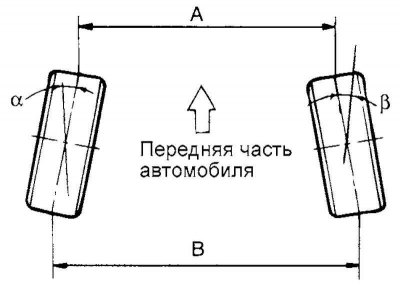
Pic. 4.1. wheel alignment
wheel alignment (size difference B - A or the sum of angles a + b) adjustable by turning the tie rod ends (pic. 4.1).
To change the wheel alignment, rotate the right and left tie rod ends at equal angles in opposite directions. The amount of toe-in will decrease as the left tie rod end is rotated towards the rear of the vehicle (and the tip of the right steering rod - towards the front of the car).
Convergence B-A: nominal value - 0±2 mm.
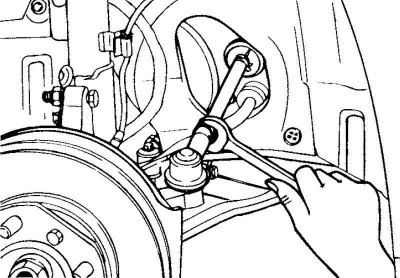
Pic. 4.2. Wheel alignment
Wheel alignment is adjusted by turning the left and right tie rod ends at the same angles (pic. 4.2).
When adjusting the toe-in, loosen the clamps of the protective covers of the steering rods to prevent twisting of the covers.
After adjustment, securely tighten the tie rod end locknuts and securely install the boot clamps.
Adjust the wheel alignment so that the result is in the +1mm range.
The moment of an inhaling of a locknut of a tip of steering draft: 50–55 Н·м.
Camber
The camber of the front wheels is provided by the geometry of the front suspension (mutual position of the steering knuckle and the front suspension strut) those. adjusted at the factory and cannot be adjusted during operation.
Camber: 0°+ 301.
Pitch
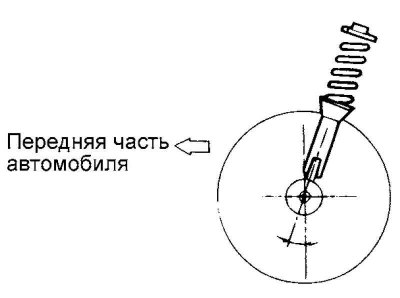
Pic. 4.3. Pitch
The longitudinal inclination of the axis of rotation is adjusted at the factory and cannot be adjusted during operation (pic. 4.3).
If the caster is out of specification, replace any deformed or damaged suspension parts.
Longitudinal inclination of the axis of rotation: 2°49' +30'.
Note. Worn or damaged front suspension parts should be replaced before wheel alignment is checked.
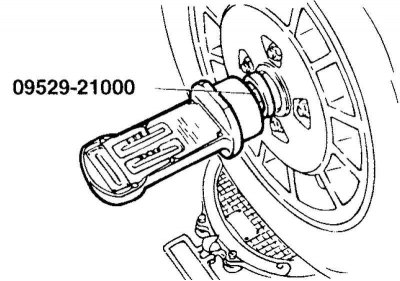
Pic. 4.4. Special tool for measuring wheel alignment
A special device is used to measure wheel alignment angles (09529-21000) (pic. 4.4).
The longitudinal inclination of the axis of rotation and the camber are adjusted at the factory and cannot be adjusted during operation.
If caster and camber are not within specification, replace deformed or damaged suspension parts.
Installation angle difference (longitudinal inclination of the axis of rotation and camber) between the right and left wheels should be within 0°±30'.
Rear wheel alignment
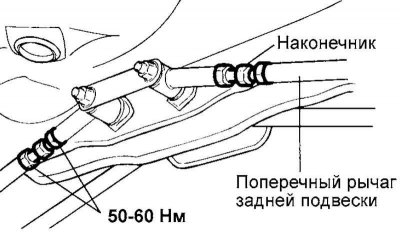
Pic. 4.5. Left transverse arm end
Turning the tip of the left transverse arm clockwise increases the toe-in (pic. 4.5).
Turning the tip of the right transverse arm clockwise reduces toe-in (see fig. 4.5).
Nominal value: 3–7 mm.
Adjustment of the convergence of the rear wheels is made by changing the length (turning the tips) transverse suspension arms.
Tire wear
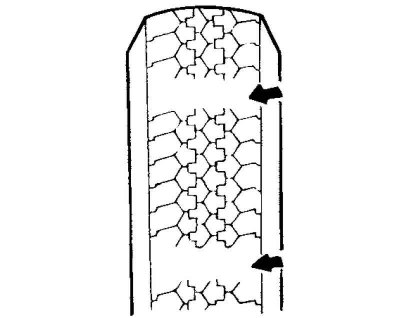
Pic. 4.6. Tire tread height
Measure the tread height of your tires (pic. 4.6).
Tire tread height (minimum allowable value): 1.6 mm.
If the tread height is less than the minimum allowable value, replace the tire.
Note. When the minimum allowable tread height is reached, wear indicator strips appear on the tire.
Wheel runout measurement
Hang the wheels of one of the axles of the car and install safety racks under the car.
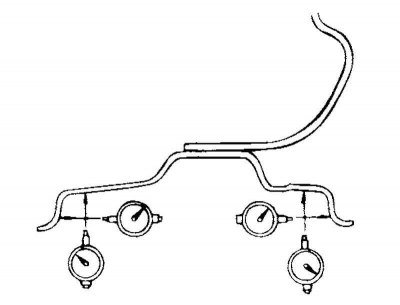
Pic. 4.7. Wheel runout measuring points
Measure wheel runout with a dial gauge as shown in figure 4.7.
Replace the wheel if its runout exceeds the limit.
Wheel runout (maximum permissible value of the radial runout of the steel disk): 0.6 mm.
Aluminum Disc:
- Axial - 1.0 mm
- Radial - 0.3 mm
- Axial - 0.3 mm
Tightening the wheel nuts
The tightening torque of the wheel nuts for a wheel with a steel rim and a wheel with an aluminum rim is the same.
Tightening torque: 90–110 Nm.
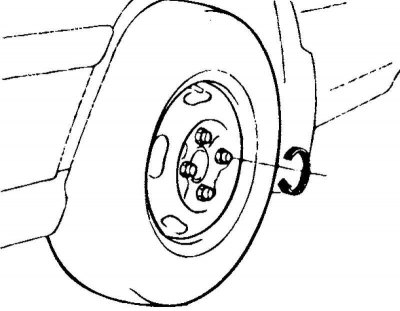
Pic. 4.8. Tightening the wheel nuts
Attention! After tightening the nuts with a pneumatic tool (impact wrench) check the final tightening torque with a torque wrench (pic. 4.8).
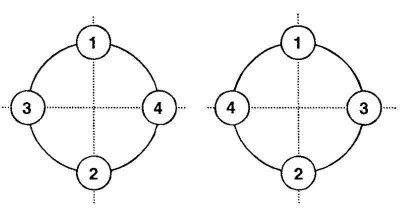
Pic. 4.9. Wheel nut tightening order
Wheel nut tightening order (pic. 4.9).
Check the tightening torque of the wheel nuts after tightening them to the nominal torque in a diagonal sequence.
Wheel swap
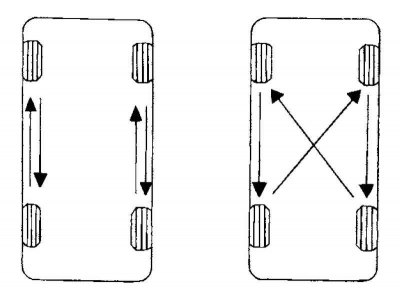
Pic. 4.10. Wheel swap diagram
When rearranging the wheels, use the diagram shown in Figure 4.10.
Stability check
If the vehicle pulls to the side while driving, swap the wheels according to the procedure below.
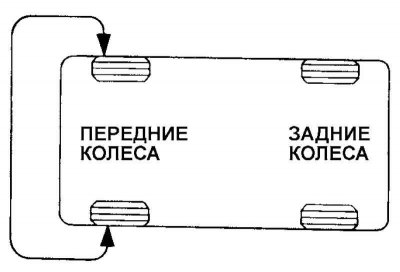
Pic. 4.11. Reinstallation of wheels when checking vehicle directional stability
Swap the front right and front left wheels, then perform a road test to check the vehicle's directional stability (pic. 4.11).
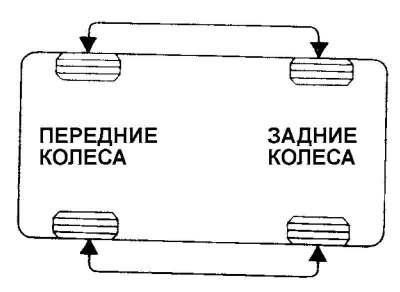
Pic. 4.12. Scheme of reinstallation when driving the car in the opposite direction
If the vehicle pulls in the opposite direction, swap the front and rear wheels, then road test again (pic. 4.12).
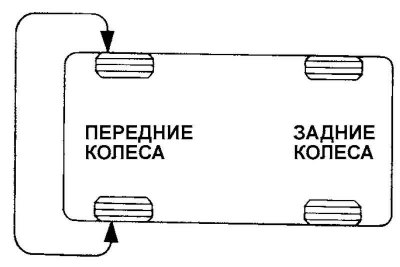
Pic. 4.13. Scheme of secondary reinstallation when driving the car to the side
If the vehicle pulls to the side, swap the front right and front left wheels again, then road test (pic. 4.13).
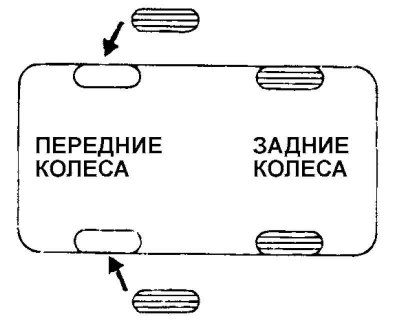
Pic. 4.14. Wheel replacement
If the vehicle pulls in the opposite direction, replace the front wheels with new ones (pic. 4.14).
